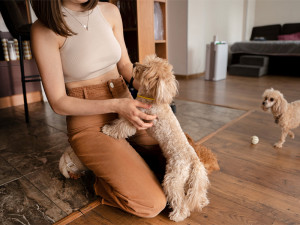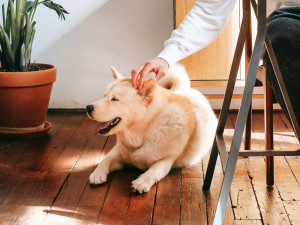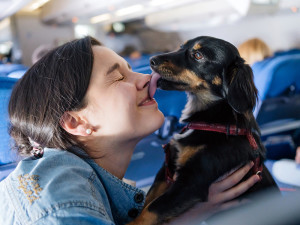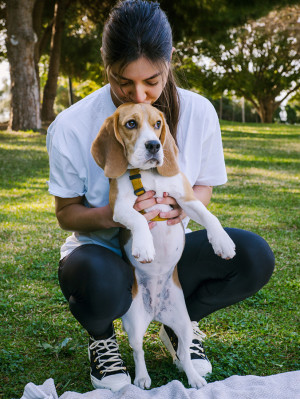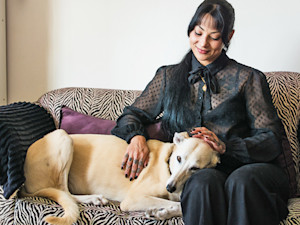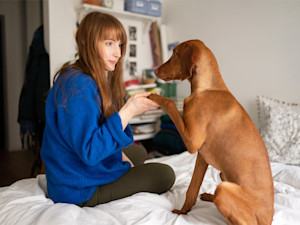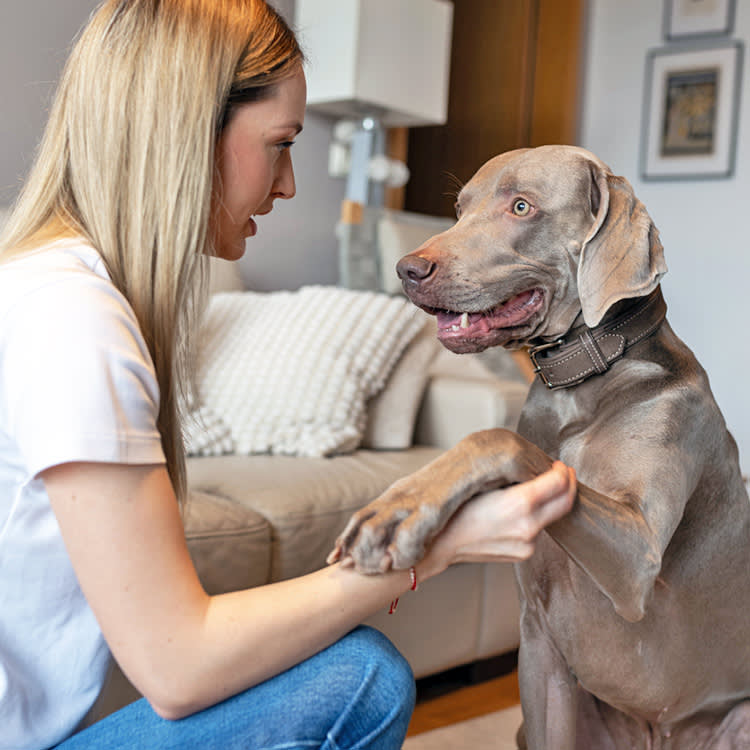
Share Article
In This Article:
The Most Common Reasons Dogs Put Their Paw on You Should You Let Your Dog Paw on You? Addressing Unwanted Pawing Nurturing a Positive Paw Connection
It starts cute. Your dog looks at you with those adorable eyes, lifts one paw, and gently rests it on your leg. Maybe you think, Aww, they love me. And perhaps you’re right. However, by the third or fourth time they do it in an hour, or dig their paw into your arm as you’re holding a cup of coffee, it begins to feel less like affection and more like interruption.
The question is: Why is your dog putting their paw on you in the first place?
Dogs don’t speak our language, but they’re constantly trying to communicate. Pawing is one of their favorite ways to interact. Whether a nudge for more food, a plea for attention and reassurance, or an enthusiastic sign of affection, that lifted paw means something. The challenge is figuring out what.
Understanding the context, your dog’s personality, and body language can help you translate pawing behavior into meaningful cues. Because once you know why your dog paws at you, you can stop guessing and start responding the way they need.

The most common reasons dogs put their paw on you
Dogs can’t talk, but they sure know how to get your attention. When your dog puts a paw on you, they’re not just being cute. They’re trying to say something. It might be a request, a sign of love, or a way to calm themselves down.
Here are the most common reasons behind this familiar behavior.
They want your attention.
One of the most apparent reasons dogs place their paw on you is because they want your attention, and it probably worked the first time they tried it. Maybe you were scrolling on your phone or working on your laptop and didn’t notice them at your feet. So, they placed a paw on your arm, and voilà: You looked at them.
Mission accomplished.
Over time, this action can become habitual. Dogs are creatures of association. If pawing you gets a belly rub, a treat, or even just eye contact, they’re going to repeat the behavior. It’s not manipulation; it’s just smart reinforcement learning.
They are hungry.
Dogs are incredibly tuned in to mealtimes. If your dog paws at you around the same time every day, and it coincides with their breakfast or dinner, chances are they’re reminding you it’s time to eat. Some dogs will sit by their bowl. Others get a little more direct and tap you like, Hey, remember me? I eat every day, too.
If you respond by getting up and feeding them, the behavior is reinforced, and the paw becomes their meal bell.
They need to go outside.
Pawing can also be a learned bathroom signal, especially in dogs who haven’t taken to barking or scratching at the door. If you’ve ever let them out after a paw tap, they might use this as their preferred method of saying I’ve got to go.
This is an excellent opportunity to teach them a more consistent signal, like ringing a bell near the door or sitting in a specific spot. But if pawing is their current language, it’s worth observing the timing, especially after meals or long naps.
They are anxious.
Pawing can also be a sign of stress or uncertainty. Anxious dogs might seek reassurance through physical touch, often resting their paw on your leg or arm while looking for cues that everything is okay. This type of pawing is usually gentler and paired with submissive body language, such as ears back, head low, and tail still.
In these moments, your dog isn’t trying to be needy. They’re trying to feel safe. Instead of pushing them away or ignoring them, help them calm down with gentle words, pets, or a short walk to redirect their energy.
They are showing love.
Not all pawing is a demand. Sometimes, it is just affection. In the same way a dog leans into you, places their head on your lap, or nuzzles your hand, putting a paw on you can be their version of a hug. You’ll often see this during calm bonding time: on the couch, during a petting session, or when you're winding down at the end of the day.
If the paw is soft and your dog looks relaxed, you can take it as a good sign. They’re comfortable. They trust you.
They have a medical issue.
If the pawing seems out of character or is suddenly constant, it’s worth considering a medical cause. Pain, itchiness, or neurological issues can cause dogs to seek comfort through touch or try to get your attention to help them.
Watch for signs like limping, licking one paw obsessively, or being unusually clingy. If something feels off, it’s a good idea to schedule a checkup. Dogs may not have words, but they do have instincts. Sometimes, pawing is their way of telling you something’s wrong.
Should you let your dog paw at you?
Yes, it is generally fine to let your dog paw at you occasionally, as long as the behavior is gentle and not disruptive. Pawing is a natural way for dogs to communicate, and in many cases, it can be a sweet display of affection or a simple request for attention. During relaxed moments, such as cuddling on the couch or playing together, allowing this behavior can strengthen your bond.
However, problems can arise when pawing becomes excessive, demanding, or paired with unwanted behaviors like barking, whining, or jumping.
If your dog starts pawing at you constantly, especially when you are busy, it may be a sign that they have learned to get what they want by interrupting your space. This can create unhealthy patterns and blur the boundaries between attention-seeking and pushy behavior. What starts as a small gesture can grow into a larger behavioral issue if not addressed consistently.
Addressing unwanted pawing
To stop your dog from pawing inappropriately, begin by figuring out what they are trying to communicate and find healthier ways for them to express it. Is your dog bored, restless, hungry, or anxious? Once you know the cause, you can meet their need without reinforcing the pawing.
For example, if your dog paws because they are bored, offer more structured activities, like interactive toys or short training sessions. If they are hungry, make sure you are feeding them on a consistent schedule so they do not rely on physical cues to prompt you. If they are seeking attention, ignore the pawing and reward them when they remain calm and quiet.
Teaching alternative behaviors is also helpful. Cues like “sit,” “down,” or “place” can give your dog a more appropriate way to get your attention. When they choose those actions instead of pawing, reward them with praise or a small treat. Over time, they will learn that calm behavior is what gets results.
Nurturing a positive paw connection
You can turn pawing into something positive by giving it structure and purpose through training. Teaching tricks like “shake” or “high five” allows your dog to use their natural instincts playfully and appropriately. These interactions give your dog an outlet and help you both communicate more clearly.
Bottom line
Dogs use their paws to communicate in ways that feel natural to them. Once you start paying attention to when and how your dog paws at you, it becomes easier to understand what they need and how to respond in a way that builds trust and clarity.
According to Mary Burch, Ph.D, a certified applied animal behaviorist in Greensboro, North Carolina, “When your dog puts a paw on you, it’s a sign of communication, and doesn’t always mean the same thing. They may be hungry, need to go outside, or be seeking your attention.”
Not every instance of pawing needs correction, but it also should not be ignored if it starts crossing into demanding or disruptive behavior. The key is to find the balance between connection and structure.
References
Center for Urban Resilience. Dog Body Language. Loyola Marymount University (Urban EcoLab Module 09), https://academics.lmu.edu/media/lmuacademics/cures/urbanecolab/module09/Dog%20Body%20Language.pdfopens in new tab.
Trupanion Pet Insurance. “Why Does My Dog Paw at Me? 6 Possible Reasons.” Trupanion, https://www.trupanion.com/pet-blog/article/why-does-my-dog-paw-at-meopens in new tab.

Valerie Mellema
Valerie Mellema has a Bachelor of Science in Agribusiness and Equine Industry from West Texas A&M University. She has been a professional writer for the past 20 years, covering a wide variety of pet health and care topics before founding a nonprofit focused on mental health in children and thoroughbred aftercare. She has four Border Collies and eight retired racehorses.
Related articles
Why Does My Dog Lick Me? The Meaning Behind Dogs Licking Us
The sentiment is nice, but...
Do Dogs Like Getting Kisses?
No, your dog might not like receiving kisses as much as you like giving them.
![Woman petting her dog on the couch.]()
10 Signs Your Dog Trusts You
Your pup will act this way when they feel safe and secure.
![A woman sitting on her bed, holding her dog's paw in her palm.]()
“How Do I Get My Dog to Stop Pawing at Things?”
Dog trainer Robert Haussmann’s tips for teaching a pushy pup that there are friendlier ways to get what they want.
Can Dogs Sense When You’re Sad?
It certainly seems like it sometimes.
Why Does My Dog Paw at Me?
Hey, there little guy—what’s up?
